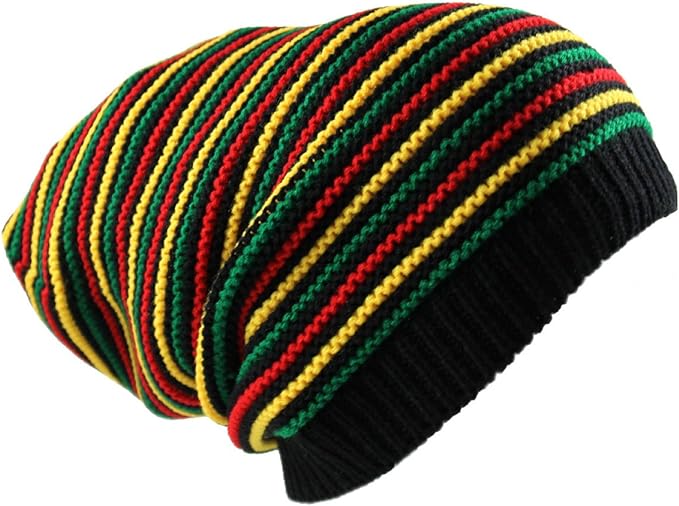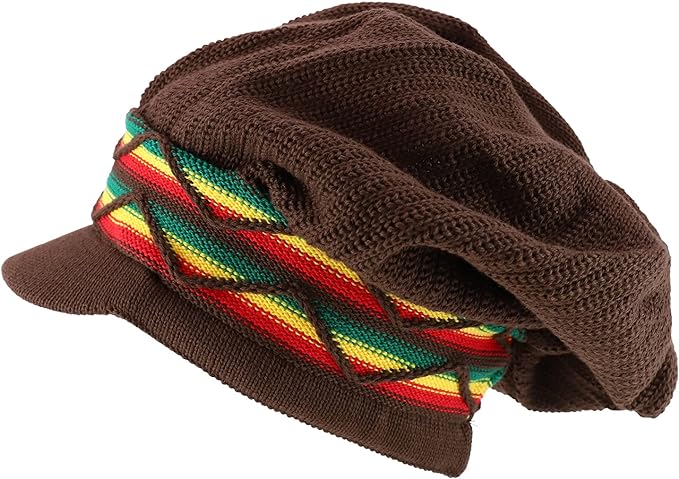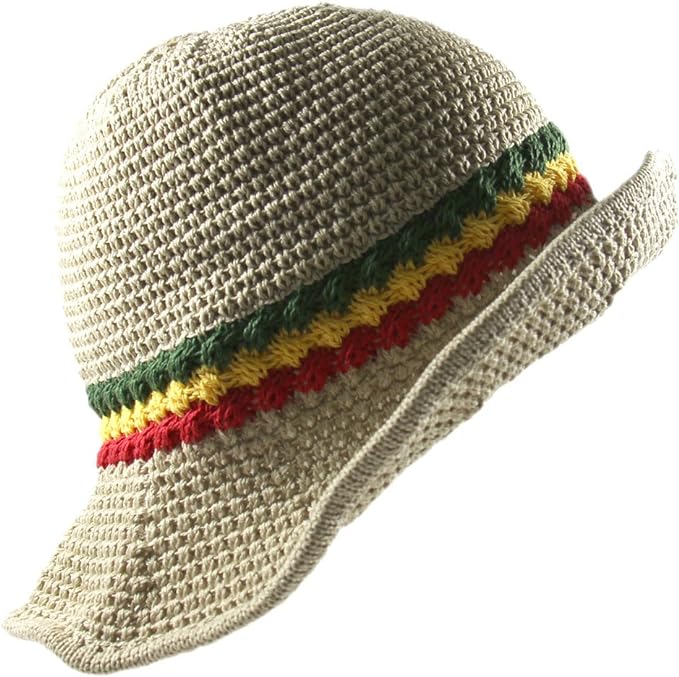Table of Contents
As an Amazon Associate I earn from qualifying purchases.
Rastafarian hats are an important cultural heritage of Jamaica, which is a vibrant island nation nestled in the heart of the Caribbean. The island’s diverse heritage is a harmonious blend of African, European, Indigenous, and Asian influences, giving rise to a dynamic cultural landscape that captivates the world. From its lively music and dance to its delectable cuisine and colorful fashion, Jamaica stands out as a cultural gem, celebrated for its resilience, warmth, and distinctiveness.
In this blog post, we will delve into the enchanting world of Jamaican beauty and identity as exemplified by the iconic Rastafarian hats. From its historical roots to its contemporary influence, we will explore the profound impact this accessory has had on Jamaican culture and beyond. Moreover, we will celebrate the empowerment that comes from embracing one’s identity through fashion and encourage readers to embrace their unique style as a reflection of their inner selves.
Join us on this captivating journey through the colors, patterns, and stories of the Rastafarian hat as we discover the profound beauty and strength that emerges when we proudly embrace our cultural heritage through the art of fashion. Let the Rasta hat guide us as we delve into the heart of Jamaican identity and celebrate the diversity that makes each of us truly extraordinary.
>>> Check out Rastafarian shirts
Deciphering the Rastafarian Hat Meaning
With its vibrant colors, bold patterns, and unique design, the Rastafarian hat tells a powerful story of Jamaican heritage. The hat’s red, gold, and green hues symbolize the Rastafarian principles of love, wealth, and life, while the lion emblem represents the strength and courage of the Jamaican people. Embraced by locals and cherished by visitors alike, the Rasta Hat showcases the beauty of Jamaica’s cultural fusion and serves as a testament to the island’s storied history.
Rastafarian clothing and accessories are an expressive form of art, which extends beyond fabric and design; it serves as a conduit for embracing one’s identity and heritage. The Rasta Hat is not merely an accessory; it is a statement of self-discovery, a symbol of pride, and a proclamation of cultural belonging. Through fashion, individuals find a powerful means of celebrating their roots, expressing their individuality, and connecting with their community.
The Origin of Rastafarian Hats
The story of the Rasta Hat dates back to the early 20th century in Jamaica, during a time of social and cultural transformation. It emerged as an emblem of the Rastafarian movement, a spiritual and cultural movement that originated in the 1930s. The movement was deeply influenced by Marcus Garvey’s teachings, which emphasized the pride and empowerment of black people worldwide.
The Rastafarian hat: also known as the “tam” or “tam cap,” draws inspiration from the traditional headwear of East African warriors. Rastafarians sought to reconnect with their African roots, and the hat became a tangible expression of this desire. Its design includes a crown-like shape and a brimless structure, offering a distinctive and recognizable appearance.
The Rastafarian hat is infused with profound symbolism, reflective of the Rastafarian movement’s principles and beliefs. The colors of the hat hold special significance are:
- Red: Symbolizes the blood of those who suffered during slavery and represents the struggles faced by people of African descent. It is a call for justice, redemption, and liberation.
- Gold (Yellow): Represents the wealth of the homeland, Africa. It is a testament to the inherent richness and beauty of the African continent.
- Green: Symbolizes the abundant vegetation of Ethiopia, the spiritual homeland for Rastafarians. It is also associated with growth, life, and prosperity.
These Rastafarian clothes colors combination of red, gold, and green is not only visually striking but also serves as a powerful reminder of the Rastafarian movement’s core principles of love, unity, and pride in African heritage.
Spiritual Meaning Behind the Rastafarian Hats
The Rastafarian hat holds a deep spiritual connection within the Rastafarian movement. The movement is rooted in the belief that Emperor Haile Selassie I of Ethiopia, known as “Ras Tafari,” is the earthly representation of God (Jah). Rastafarians view Ethiopia as their spiritual homeland, and the hat’s colors pay homage to the Ethiopian flag.
The lion emblem often found on the Rastafarian hat is a direct reference to Emperor Haile Selassie I, who is referred to as the “Conquering Lion of the Tribe of Judah” in Rastafarian theology. The lion is a symbol of strength, royalty, and the lineage of King Solomon and Queen of Sheba.
Wearing the Rasta Hat, therefore, is not only a fashion statement but also a sacred act of devotion and spiritual connection for Rastafarians. It represents their commitment to their faith, their African roots, and their pursuit of justice and equality for all.
Celebrating Jamaican Beauty by Wearing the Rastafarian Hats
Regardless of one’s ethnicity or heritage, the Rastafarian hats represent a collective pride in Jamaican identity and heritage. By embracing this iconic accessory, Jamaicans celebrate their individual beauty while appreciating the beauty found within the rich tapestry of their fellow citizens.
Rastafarian hats act as a powerful statement of pride and celebration of natural hair and hairstyles within Jamaican culture. For centuries, people of African descent have faced societal pressures to conform to Eurocentric beauty standards, often leading to the use of chemicals or extensions to alter their hair texture. However, with the rise of the Rastafarian movement and the popularity of the Rasta Hat, there has been a remarkable shift in embracing natural hair.
The hat’s brimless design allows for showcasing diverse hairstyles, from dreadlocks to afros, without compromising their shape or form. This acceptance and celebration of natural hair through the Rasta Hat represent a significant step towards dismantling beauty norms that marginalize and limit the authentic expression of Jamaican beauty.
The vibrant colors and bold patterns of the Rasta Hat have a remarkable ability to complement various skin tones and facial features. The red, gold, and green hues, infused with the significance of the Rastafarian movement, exude a sense of energy and vibrancy that resonate with people of all backgrounds.
For individuals with darker skin tones, the Rasta Hat provides a striking contrast, accentuating their features and creating a stunning visual impact. Meanwhile, for those with lighter skin tones, the hat’s vivid colors add a pop of life and liveliness, elevating their overall look.
Furthermore, the Rasta Hat’s crown-like shape frames the face beautifully, drawing attention to the wearer’s eyes and smile. This inclusive design and color palette allow individuals from all walks of life to embrace the Rasta Hat as a means of celebrating their unique beauty and identity.
Expressing Personal Style bwith Rastafarian Hats
Expressing personal style with Rastafarian hats is an exciting journey of self-discovery and creativity. The beauty of this iconic accessory lies in its versatility, allowing it to seamlessly complement a wide range of fashion preferences. Whether you’re a fan of casual cool streetwear or embrace the bohemian vibes, there’s a Rasta Hat style that perfectly matches your taste.
For those laid-back days, opt for the classic red, gold, and green Rasta Hat, and pair it with a graphic t-shirt, distressed denim jeans, and sneakers for an effortlessly cool look. If you’re in the mood for something whimsical and free-spirited, a crochet Rasta Hat adorned with beads and feathers will elevate your bohemian ensemble, such as a flowing maxi dress, leather sandals, and layered jewelry.
Not just limited to casual wear, the Rastafarian hat meaning adds flair to formal occasions as well. Choose a sleek and well-fitted hat made from premium materials like wool or felt, and pair it with a tailored suit or a stylish dress for a touch of elegance and sophistication.
The Rasta Hat can also elevate your gym-to-street style. Embrace athleisure with a sporty beanie-style Rasta Hat, which perfectly complements leggings, a sports bra, and a bomber jacket. It’s a great way to add a fashionable touch to your workout ensemble.
Even during colder months, the Rasta Hat remains a go-to accessory. Stay cozy and stylish with a knitted Rasta Hat, and pair it with a chunky sweater, jeans, and ankle boots for a chic winter outfit.
The Versatility of Rastafarian Hats
What makes the Rasta Hat truly unique is its adaptability to different occasions, allowing you to effortlessly transition from beachside elegance to formal events and everything in between. Don’t hesitate to experiment and find the Rasta Hat style that resonates with your personality and fashion preferences.
Personalization is the key to making your Rastafarian hat meaning truly your own. Consider adding pins, patches, or embroidery that hold sentimental value to infuse the hat with personal significance. The more you make it your own, the more it becomes an extension of your identity and style.
Embrace Rastafarian hat meaning with confidence and pride, as fashion truly comes alive when it reflects your inner self. Whether you wear it as a symbol of cultural pride, a statement of fashion-forwardness, or simply as an accessory you love, the Rasta Hat is your canvas for self-expression. Celebrate the beauty of individuality and let your unique style shine through with the iconic Rasta Hat.
Embracing Cultural Identity with the Rastafarian Hat Meaning
The Rastafarian hat holds a special place in the hearts of many individuals, as it goes beyond being a mere accessory to becoming a powerful symbol of empowerment and confidence. Countless people from diverse backgrounds have shared their stories of how donning the Rasta Hat has positively impacted their lives.
For some, wearing the Rasta Hat is an act of cultural pride, a way of celebrating their Jamaican heritage and connecting with their roots. It serves as a reminder of the strength and resilience of their ancestors, instilling a sense of belonging and cultural identity.
Others have expressed how the Rastafarian hat meaning gives them a sense of boldness and fearlessness. The vibrant colors and distinctive design stand out in a crowd, making a statement and commanding attention. This newfound confidence often spills over into other aspects of life, inspiring individuals to take on challenges with courage and self-assurance.
Fashion has a remarkable influence on our emotions and mental well-being. Embracing one’s culture and identity through fashion, particularly with the Rastafarian hat meaning, can have a profound psychological impact. It fosters a sense of authenticity and self-acceptance, allowing individuals to feel more comfortable in their own skin.
When someone wears the Rasta Hat, it can act as a shield against external pressures to conform to mainstream beauty standards. Instead, it encourages a celebration of uniqueness and individuality. This acceptance of one’s identity, without feeling the need to assimilate, leads to increased self-esteem and improved mental resilience.
Moreover, embracing one’s culture through women’s rasta clothing fashion nurtures a deeper understanding and appreciation of one’s heritage. It strengthens the connection to one’s roots and creates a sense of continuity with the past, present, and future. This newfound cultural pride often translates into a more positive outlook on life and a greater sense of purpose.
For many, the Rastafarian hat meaning is more than just a piece of clothing; it is a symbol of pride and belonging. When wearing the hat, individuals become part of a larger community that shares a common heritage and values. This sense of belonging fosters a feeling of support and unity, instilling a sense of collective identity.
The Rastafarian hat also serves as a reminder of the Rastafarian hat meaning of love, unity, and equality. It becomes a beacon of hope and a call to action for creating a more inclusive and compassionate world. In a society that often emphasizes differences, the Rasta Hat serves as a unifying force, bringing people together under the banner of cultural appreciation and respect.
Cultural Awareness and Respect: Honoring the Rastafarian Hat Meaning
The Rasta Hat is not just a trendy fashion accessory; Rastafarian hat meaning holds profound cultural significance deeply rooted in the history of the Rastafarian movement and Jamaican identity. As individuals who appreciate and celebrate this iconic headwear, it is vital to understand its heritage and the principles it represents. By doing so, we show respect for the culture from which it originates and acknowledge the struggles and triumphs that have shaped its meaning.
Awareness of the Rastafarian hat meaning allows us to view it beyond its visual appeal. It serves as a bridge between cultures, reminding us of the importance of cherishing and preserving cultural heritage in an increasingly interconnected world.
To fully grasp the significance of the Rastafarian hat meaning, it is essential to explore the Rastafarian movement’s roots and its impact on Jamaican identity. The Rastafarian movement emerged in the 1930s, advocating for social justice, equality, and spiritual consciousness. It was a response to the oppression faced by people of African descent, with a focus on reclaiming their African heritage and identity.
The Rastafarian movement brought forth the belief that Emperor Haile Selassie I of Ethiopia was the divine manifestation of God (Jah) and established Ethiopia as their spiritual homeland. The movement’s principles centered around love, unity, and the empowerment of black people worldwide.
The Rasta Hat, with its colors and lion emblem, symbolizes the values and beliefs of the Rastafarian movement. Understanding the movement’s history and principles helps us appreciate the deeper significance of the Rasta Hat as an embodiment of cultural pride and spiritual connection.
As we admire and incorporate the Rasta Hat into our fashion and style, it is crucial to approach cultural appreciation with sensitivity and respect. Cultural appreciation entails understanding and honoring the cultural significance and history of the Rasta Hat without reducing it to a mere fashion trend or caricature.
Appropriation, on the other hand, occurs when elements of a culture are taken out of context and used in ways that disrespect or demean the original culture. To avoid appropriation, refrain from using the Rasta Hat for costumes or caricatures that perpetuate stereotypes. Instead, celebrate its beauty and cultural significance while acknowledging and respecting its origins.
By advocating for cultural appreciation, we embrace the diverse beauty and richness of Jamaican culture. We can promote cultural exchange and understanding, fostering a more inclusive world that recognizes and respects the uniqueness of each culture.
Supporting Local Artisans and Communities: Sustaining Jamaican Culture through the Rasta Hat
When we choose to purchase authentic Rasta Hats from Jamaican artisans and businesses, we contribute to the preservation of Jamaican culture and heritage. Supporting local creators not only helps sustain traditional craftsmanship but also empowers communities by creating economic opportunities.
Jamaican artisans pour their hearts and souls into handcrafting each Rasta Hat, ensuring that every piece embodies the essence of their cultural heritage through Rastafarian hat meaning. By valuing their craftsmanship and expertise, we show appreciation for the artistry behind the Rasta Hat, making it more than just a fashion statement but a tribute to the skill and passion of its creators.
Readers looking to purchase authentic Rasta Hats can explore a variety of avenues that support local artisans and businesses in Jamaica. Many artisans sell their creations at local craft markets, where visitors can witness the craftsmanship firsthand and engage with the creators themselves. These markets not only offer a chance to purchase authentic Rasta Hats but also provide insight into the cultural significance of the hats and the stories of their makers.
Additionally, online platforms that specialize in promoting and selling handmade items from Jamaica or Rasta women’s clothing can be excellent resources for finding Rastafarian hat meaning. These platforms often connect customers directly with artisans, providing a seamless way to support local communities and sustain Jamaican culture.
Supporting local creators is a powerful means of preserving and promoting Jamaican culture. By investing in authentic Rasta Hats made by Jamaican artisans, we ensure that traditional craftsmanship and cultural practices are passed down to future generations.
The income generated from the sale of Rasta Hats helps sustain local communities and empowers artisans to continue their creative work. This, in turn, fosters a sense of pride and purpose within the community, reinforcing the significance of their cultural heritage.
Furthermore, when people from around the world appreciate and embrace the Rasta Hat as a symbol of Jamaican culture, it fosters cross-cultural understanding and respect. As the demand for authentic Rasta Hats grows, it amplifies the voice of Jamaican artisans on the global stage, shining a spotlight on the richness of Jamaican culture.
Embracing Jamaican Beauty Beyond the Rasta Hat: Exploring Fashion and Culture
Jamaican fashion and culture offer a diverse world of beauty beyond the Rastafarian hat meaning. From traditional clothing like the vibrant Jamaican dress to contemporary streetwear, there is much to explore. Jamaican jewelry with its intricate craftsmanship and colorful designs adds a unique touch to personal style.
The fusion of traditional and modern styles in Jamaican fashion is captivating. Designers skillfully blend elements from the past with contemporary aesthetics, creating innovative and culturally rich designs.
Embracing Jamaican beauty extends beyond fashion to encompass art, music, dance, and culinary traditions. The dynamic nature of Jamaican culture shines through these various elements, celebrating the depth and diversity of the country.
As we appreciate the creativity of Jamaican designers and artists, we recognize how they preserve cultural heritage while embracing innovation. Contemporary Jamaican fashion embodies the progressive spirit of the country.
It’s essential to cultivate open-mindedness and curiosity about diverse fashion trends and styles from around the world. By embracing the beauty of diversity, we celebrate cultural exchange and unity.
Understanding and respecting the cultural significance behind fashion choices is important. Cultural appreciation fosters a world where fashion becomes a platform for appreciation and understanding.
Conclusion
As we conclude our exploration of Jamaican beauty and identity, the significance of the Rastafarian hat meaning stands tall as a powerful symbol of cultural pride. Beyond being a trendy accessory, it embodies the essence of Jamaican heritage and serves as a bridge between diverse communities.
The Rasta Hat’s vibrant colors, bold patterns, and lion emblem encapsulate the principles and beliefs of the Rastafarian wear movement, echoing the strength and unity of the Jamaican people. By wearing the Rasta Hat with confidence, we celebrate the rich tapestry of Jamaican culture and its enduring legacy.
Through fashion, we have the incredible opportunity to express our unique style and embrace our cultural heritage. Just as the Rastafarian hat meaning has become an iconic symbol of Jamaican identity, our personal style can reflect the beauty of our individuality, showcasing the depth and diversity within ourselves.
As we appreciate the beauty of Jamaican culture, let us remember to celebrate diversity and cultural expression worldwide. Fashion serves as a powerful medium for cross-cultural understanding, allowing us to unite in a shared appreciation for global heritage.
In closing, let the Rastafarian hat meaning inspire us to embrace our true selves with pride and to respect the cultural significance behind fashion choices. Embrace your unique style, wear it with confidence, and find empowerment through the expression of your identity. By celebrating diversity and honoring the beauty of cultural heritage, we can weave a tapestry of unity and understanding that transcends borders and unites us all. So, let us step into the world with boldness and appreciation for the beauty that each individual and culture brings to our global community.















Leave a comment
Your email address will not be published. Required fields are marked *
You must be logged in to post a comment.